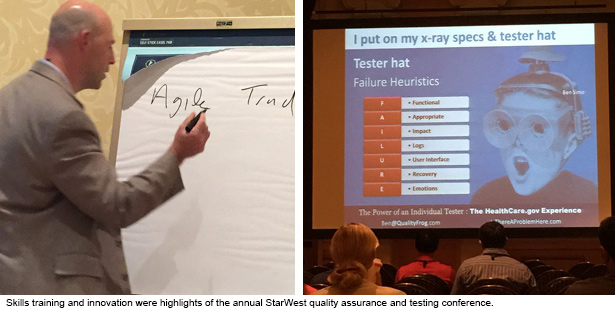QA and Testing Pros Focus on Skills, Innovation at StarWest
 Earlier this month, I participated in the StarWest Conference for software testers and quality assurance professionals at Anaheim, California. Many of the best and brightest in our industry attended, and it was clear to me that we are entering a period of rapid innovation and growth in the QA and testing arena.
Earlier this month, I participated in the StarWest Conference for software testers and quality assurance professionals at Anaheim, California. Many of the best and brightest in our industry attended, and it was clear to me that we are entering a period of rapid innovation and growth in the QA and testing arena.
New technology and better training make this an exciting time to be in our field. Below are six themes from the conference that are resonating with me and speak to the growing influence of QAT professionals in IT organizations of all sizes.
1. Focus on skills
Many of the keynotes presentations, tutorials, and breakout sessions and the hands-on Test Lab focused on empowering testers with heuristics, methods and techniques to improve their skills. At most companies, it is no longer the acceptable norm to have untrained amateurs testing business critical applications.
2. Specialization
As software testing matures, there is more and more specialization by domain, technology and methodology. For instance, healthcare IT organizations are willing to pay a premium for testers with EMR and claims expertise. Other highly valued testing skills are mobile testing, test automation specialists, performance testers and security testers.
3. The rise of the QA and Testing leader
Several of the presenters and delegates had director-level titles and above, which was uncommon a few years back. As more companies invest in Testing Centers of Excellence, more senior leaders are required to manage large teams made up of full-time QAT professionals and contractors/consultants.
4. Tool innovation
With the increasing expectation for project quality and velocity and the advances in application technology, testing tool vendors are innovating to keep pace. For example, HP Software unveiled StormRunner Load for performance testing from the cloud, as well as additions to their suite of mobile testing tools. There was also a good deal of focus on increasing test and fix efficiency using Service and Network Virtualization tools.

5. All about the business
Quality is all about risk mitigation, business assurance and increasing customer satisfaction. Executives are realizing that quality impacts the bottom line, and IT organizations, in turn, are investing more in QAT initiatives. As I highlighted in my panel discussion on the 2014-2015 World Quality Report, more than 25 cents of every dollar spent on IT now goes to quality and testing.
6. Individual testers make a difference
For all of the conference chatter about large testing centers and sophisticated tools, I was also reminded by one speaker of how a single tester using critical thinking can make a huge difference in software quality.
If you are not familiar with the story of Ben Simo from eBay, he’s a tester whose poor user experience trying to register on the Healthcare.gov website led him down a path of identifying bugs and security concerns, which he wrote about on his blog. His findings came to the attention of Congress and were widely cited in the subsequent investigations into the flawed launch of the site.
Stories like Ben’s help validate QAT as a meaningful career path with increasing opportunities for growth and rising expectations for professionalism, domain and technology knowledge and testing skills.
Want to learn more about QAT trends? Join me for a review of this year’s World Quality Report during this October 29, 2014 webinar.
Mike Cooper is Chief Quality Officer and VP of Quality Assurance and Testing for Healthcare IT Leaders. He previously led QAT teams and initiatives at HP Software, T-Mobile USA and Equifax.
